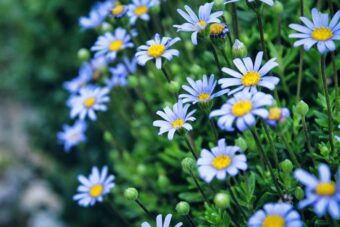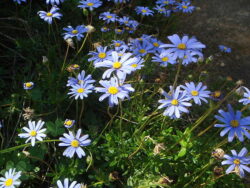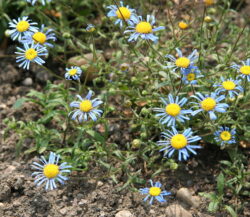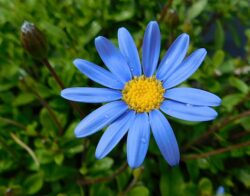In this article, we will discuss how to grow the tender perennial and half-hardy annuals in containers. The tender perennial, Felicia amelloides has the common name of Blue Daisy, whilst the half-hardy annual Felicia bergeriana has the common name of Kingfisher Daisy. They are often grown for the truest blue flower that you can find in the container garden.

They are low growing tender perennials or annuals that originate from South Africa. The biggest problem with Daisies is that they come in many colours but not true blue and this is where Felicia comes into play. The flower may be blue but you will not be blue as they produce masses of blooms all summer long well into autumn.
This is it is grown in full sun but in the shade, they will sadly close. The leaves may be variegated in some varieties but there are not so floriferous. The flowers are a magnet for various insects, especially butterflies.
In the UK, Felicias are treated as annuals but if the summers are hot they will flower from summer to autumn, whilst in cool summers they will not be as showy.
I recommend that you grow Felicias as a sole specimen, as it can be a bit of a thug, where it can crowd out weak or delicate plants.
GROWING FELICIA PLANTS IN CONTAINERS
You can Felicia by seeds or by buying garden-ready plants in late spring.
To grow Felicia from seeds, you need to sow 6 to 8 weeks before the last frosts in spring. Fill a seed tray with a good quality, seed compost that has been moistened with water and the excess allowed to drain away. On top of this, sprinkle the seed thinly so that they will not grow overcrowded. Cover with a 3mm layer of sieved compost and place a propagator lid on top of the tray. The best place on a warm windowsill where they will soon germinate.
Once they are large enough to handle, you can prick them out and place them in 15 cells tray packed full of multipurpose compost. Allow the plant to grow on before hardening off in Mid-May before planting out in late May. At this stage, you can treat your home-reared seed sown plants and shop-bought plants in the same way.
CHOOSE THE RIGHT CONTAINER

First, choose a container that will suit the plants in question. Please make sure the container has plenty of drainage holes as this can lead to root rot. Place a 1cm layer of gravel to improve drainage and on top of this add a mix of 20% by volume of horticultural grit with 80% by volume of multipurpose compost.
This is important as the growing media must be free draining. Dig a hole in the growing media slightly bigger than the root ball of the original plant. Place a plant in so that the top of the root ball is level to the top of the surface of the compost. Backfill with the growing media, ensuring that any gaps that remain are filled with more compost. Firm the plant in and water well.
Place the plant where it will get as much light as possible and ensure that it gets enough moisture until it establishes. Once it has been established the plant will take drought well. It is best in this case to water deeply to saturate the roots before letting the compost dry out somewhat before watering once more.

Give a 2 weekly feed with a high potash liquid fertilizer to keep the plant growing all season long.
One important task is that you must deadhead faded blooms as soon as they go over, as this will encourage the formation of more blooms all summer long. At midsummer, you can prune tired stems to give a later flush of new growth.
PESTS AND DISEASES
Luckily the plant is resistant to attacks from pests and diseases. If you are unlucky enough, they can suffer from attacks from aphids. It is best to use jets of water to blast them off the plant. If this does not work, you can use a systemic insecticide to kill the aphids.
VARIETIES TO GROW
The following species and varieties are recommended to be grown in containers:

Felicia amelloides (Blue Daisy) is a tender perennial that has long-lasting, showy, deep blue flowers with yellow centres. A noted variety is ‘Santa Anita’ or ‘Santa Anita Variegated’ or ‘Magic Blue Daisy’.
Felicia bergeriana (Kingfisher Daisy) is an annual grown for its electric blue, daisy-like flowers with yellow centres that are produced profusely all summer long well into autumn.
Felicia heterophylla is a matt-forming annual with blue flowers with yellow centres.
CONCLUSIONS
In this article, we have discussed how to grow Felicia in containers to give wonderful electric blue flowers with yellow centres. They are easy to grow, easy to care for and are relatively diseases and pest free.
If you want a plant that brings so much joy to you and is well worth a try then Felicia is for you, as it is easy to grow from seed or shop-bought plants.
If you have any questions or comments that you want to make on growing Felicia in containers, please do so in the comment box below.
Happy Felicia growing.
